Unveiling the Natural Wonders of Jinggangshan: A Hidden Gem
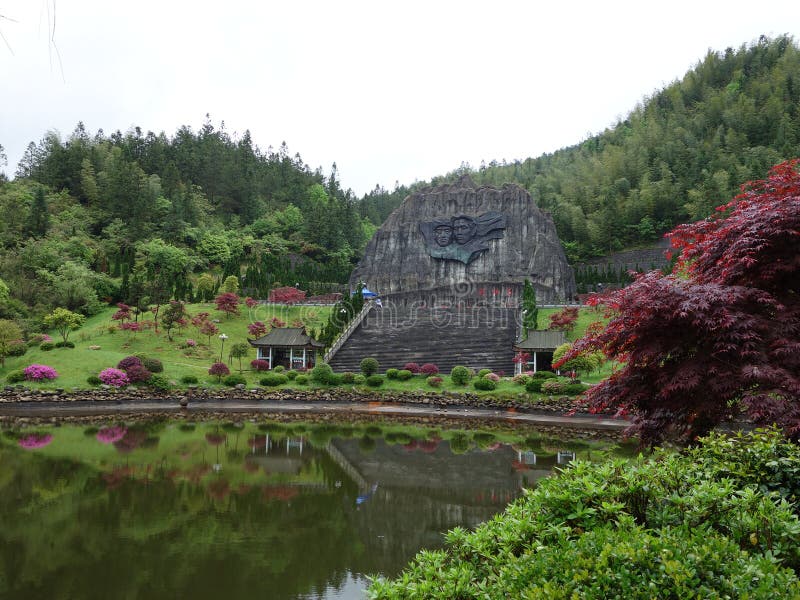
An Essential Guide to Visiting Jinggangshan
In This Guide
- An Essential Guide to Visiting Jinggangshan
- The Rich History and Legends of Jinggangshan
- Main Highlights: What You Absolutely Can’t Miss
- Planning Your Visit: A Practical Guide
- Tickets: Prices, Booking, and Tips
- How to Get There: A Complete Transportation Guide
- Local Cuisine and Accommodation Nearby
- Frequently Asked Questions
- Final Thoughts on Your Trip
Nestled in the heart of Jiangxi province, Jinggangshan is a remarkable fusion of breathtaking natural beauty and profound historical significance. Often referred to as the “Cradle of the Chinese Revolution,” this scenic area is more than just a picturesque getaway; it is a pilgrimage site for those seeking to understand the roots of modern China. The rugged terrain of the Luoxiao Mountains, characterized by steep forested peaks, cascading waterfalls, and unique rock formations, provides a stunning backdrop to a narrative that shaped a nation.
Jinggangshan is not simply a destination; it is an immersive experience that invites travelers to walk in the footsteps of revolutionary leaders, explore the remnants of a tumultuous past, and appreciate the resilience of nature. As you traverse the area, you will encounter sites of historical significance such as Mao Zedong’s former residence, the Jinggangshan Revolutionary Museum, and the solemn Revolutionary Martyrs Cemetery—each telling a story of struggle, sacrifice, and ultimate triumph.
Why Visit Jinggangshan?
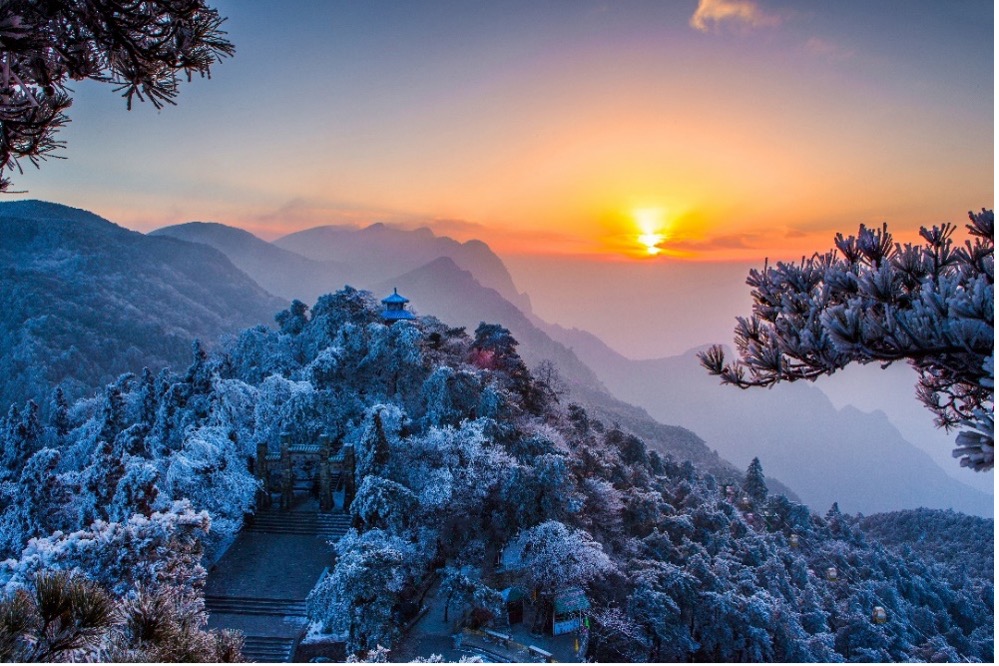
Jinggangshan.
- Rich Historical Context: As the birthplace of the Chinese Red Army, Jinggangshan offers an unparalleled opportunity to delve into the revolutionary history that has profoundly impacted China’s trajectory.
- Stunning Scenery: The area boasts an array of natural wonders, from the awe-inspiring Huangyangjie Pass, where you can marvel at a sea of clouds, to the serene Longtan Waterfalls, known for their cascading beauty.
- Culinary Delights: Indulge in local specialties such as red rice and pumpkin soup, which not only nourish the body but also carry the flavors and memories of the revolutionary era.
Whether you are a history enthusiast, a nature lover, or a culinary adventurer, Jinggangshan promises a journey that is both enriching and unforgettable. As you embark on this journey, prepare to be captivated by the stories of resilience that echo through the mountains and the vibrant culture that continues to thrive in this historical cradle.
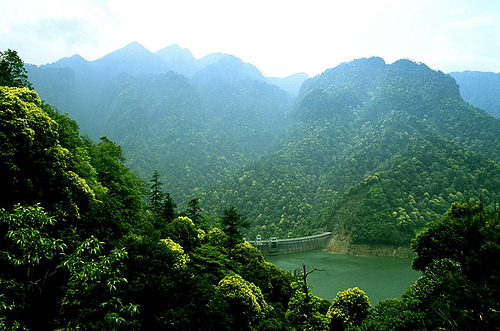
Jinggangshan.
The Rich History and Legends of Jinggangshan
Nestled in the heart of Jiangxi province, Jinggangshan is not merely a scenic wonder; it is a storied land that serves as a testament to China’s revolutionary past. The mountainous terrain, cloaked in rich forests and dotted with ancient relics, played a pivotal role during the early years of the Chinese Communist Party (CCP) and has since been revered as the “Cradle of the Chinese Revolution.”
A Revolutionary Birthplace
Jinggangshan became a crucial base for the Communist forces during the Chinese Civil War, particularly in the late 1920s and early 1930s. Under the leadership of Mao Zedong, the area served as a strategic stronghold from which the Red Army could launch significant campaigns against the Nationalist government. It was here that Mao and his comrades honed their military strategies and rallied support among the local peasantry, effectively transforming the socio-political landscape of China.
The Ciping Revolutionary Sites are among the must-visit landmarks for those wishing to delve into this rich history. Visitors can explore Mao Zedong’s former residence, where the great leader lived and worked during this tumultuous period. The site is preserved in its simplicity, allowing guests to step back in time and feel the weight of the revolutionary spirit that permeated the air.

Jinggangshan.
Legends and Lore
Beyond its historical significance, Jinggangshan is steeped in legends that add a layer of mystique to its already profound narrative. One of the most famous tales is that of the Red Army’s Long March, which began in this very region. According to local legend, the soldiers were often guided by the spirit of the mountain, which was said to bestow strength and courage to those who walked its paths. This connection to the land is still palpable today, as many visitors report a sense of inspiration when hiking the trails that Mao once traversed.
Another poignant story is that of the Red Army Hospital, which cared for wounded soldiers during battles. The tales of bravery and sacrifice echo through the halls of this historical site, reminding visitors of the human cost of revolution and the unwavering resolve of those who fought for their beliefs.
Cultural Significance
Jinggangshan is not just a place of historical events; it has also become a cultural symbol of resilience and determination. The Jinggangshan Revolutionary Museum offers an extensive collection of artifacts and exhibits that chronicle the struggles and victories of the Red Army. Here, visitors can immerse themselves in the tales of heroism that shaped modern China, gaining a deeper appreciation for the individuals who sacrificed their lives for the ideals of communism.
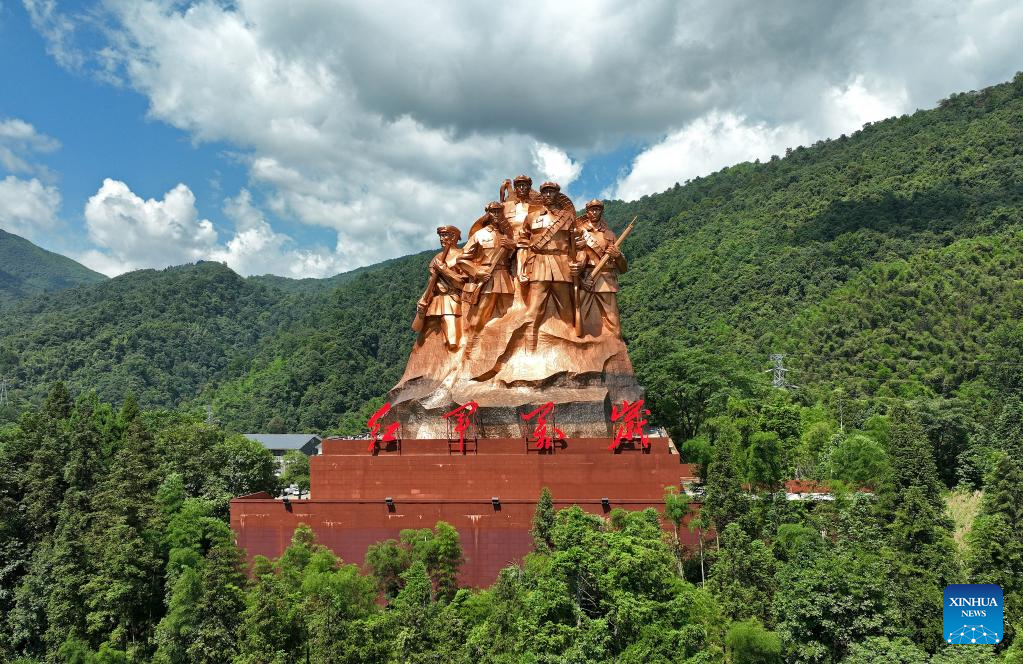
Jinggangshan.
The region’s natural beauty enhances its cultural significance. The steep, forested mountains are interspersed with breathtaking waterfalls and unusual rock formations, offering a stunning backdrop to the historical narrative. The Huangyangjie Pass is particularly renowned for its panoramic views, famously described in Mao Zedong’s poetry. As the sun rises over the sea of clouds, one cannot help but feel the weight of history and the enduring spirit of the revolution.
The Cradle of Red Tourism
Today, Jinggangshan stands as a prominent destination for “Red Tourism,” where visitors from across China and around the world come to pay homage to its revolutionary past. This movement encourages people to explore sites of historical significance, fostering a greater understanding of China’s complex history. The local economy has adapted to this influx, with amenities and activities designed to enhance the visitor experience, from guided tours of revolutionary sites to local culinary offerings that reflect the region’s heritage.
In this sacred land, where history and nature intertwine, travelers are invited to embark on a journey that goes beyond the surface. Jinggangshan is a place where stories of courage and sacrifice continue to resonate, allowing visitors to reflect on the past while being inspired by the beauty of the present. Whether you are a history buff or simply in search of a unique travel experience, Jinggangshan offers an unparalleled glimpse into the heart of China’s revolutionary spirit.
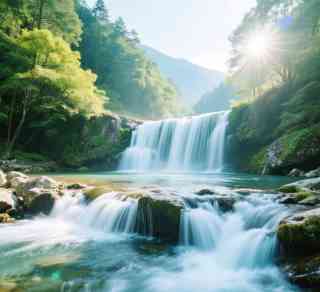
Jinggangshan.
Main Highlights: What You Absolutely Can’t Miss
Discover the Unmissable Highlights of Jinggangshan
Jinggangshan, often revered as the “Cradle of the Chinese Revolution,” is a fascinating blend of rich history and breathtaking natural beauty. Nestled in the Luoxiao Mountains of Jiangxi province, this scenic area offers an unforgettable experience for international travelers eager to delve into China’s revolutionary past while enjoying stunning landscapes. Here are the essential highlights you absolutely cannot miss during your visit.
1. Jinggangshan Revolutionary Museum
Begin your journey at the Jinggangshan Revolutionary Museum, where the comprehensive exhibits narrate the struggles and triumphs of the Communist Party during the revolutionary period. With free admission from 8:30 AM to 5:00 PM, you can immerse yourself in the rich history through a diverse collection of artifacts and multimedia displays that bring the revolutionary spirit to life.
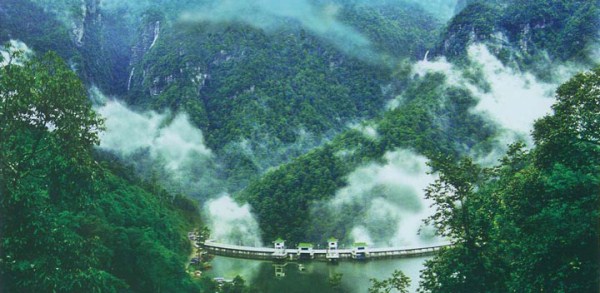
Jinggangshan.
2. Ciping Revolutionary Sites
A visit to Ciping Town is essential for understanding the historical significance of this area. Explore Mao Zedong’s former residence and the Red Army Hospital, both of which provide a glimpse into the daily lives of revolutionary leaders. This quaint town is also home to memorials that celebrate the sacrifices of those who fought for change.
3. Huangyangjie Pass
For breathtaking views, head to Huangyangjie Pass, one of the famous outposts standing at 1,343 meters above sea level. Known for its spectacular sea of clouds, this vantage point is particularly captivating at sunrise. Arriving early will enhance your experience as you witness the ethereal landscape unfold before your eyes—a scene that inspired Mao Zedong’s poetry.
4. Longtan Waterfalls
Nature lovers should not miss the Longtan Waterfalls, a stunning collection of five cascading falls that create a picturesque “three-thousand-foot silver ribbon.” The area is ideal for hiking, so ensure you wear non-slip shoes to safely navigate the terrain. The sound of rushing water and the surrounding greenery offer a tranquil escape.

Jinggangshan.
5. Bijia Mountain
Take a cable car to Bijia Mountain to enjoy the panoramic views of the Ten-Mile Azalea Corridor, especially vibrant in spring. This spot seamlessly combines natural beauty with a sense of history, making it a perfect place for reflection and photography.
6. Jinggangshan Revolutionary Martyrs Cemetery
Pay homage to the heroes of the revolution at the Jinggangshan Revolutionary Martyrs Cemetery. The solemn monuments and sculptures here commemorate those who sacrificed their lives for the cause, allowing visitors to connect with the historical significance of the site in a profound way.
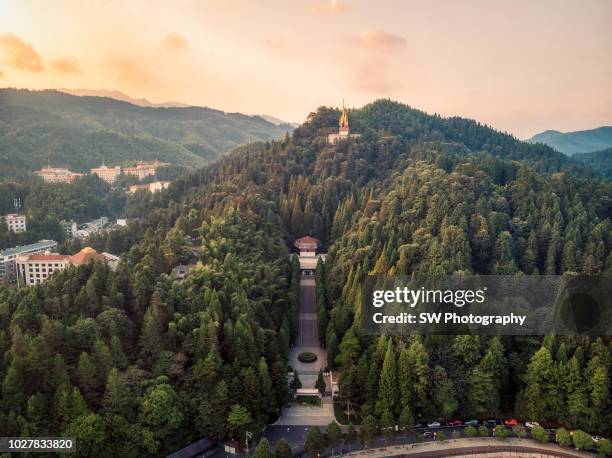
Jinggangshan.
7. Mao Zedong’s Former Residence in Dajing
Dubbed “The First Revolutionary Village,” Dajing is where Mao Zedong lived and worked. The well-preserved artifacts provide insight into the life and times of one of China’s most influential leaders. A tour through this village will deepen your understanding of the revolutionary era.
8. Octagonal Tower
Visit the Octagonal Tower, where Mao wrote his influential work, “The Struggle in Jinggang Mountains.” This historical site requires advance booking, but the experience of standing in a place that shaped revolutionary thought is invaluable.
Culinary Delights
No trip to Jinggangshan is complete without indulging in local delicacies. Be sure to try:
– Red Rice: A staple from the revolutionary era, often served with farmhouse cured meat.
– Pumpkin Soup: A sweet yet light dish that evokes memories of simpler times.
– Jinggangshan Smoked Bamboo Shoots: A unique local delicacy perfect for adventurous palates.
– Red Rice Wine: A specialty of the area, known for its mellow flavor and moderate alcohol content.
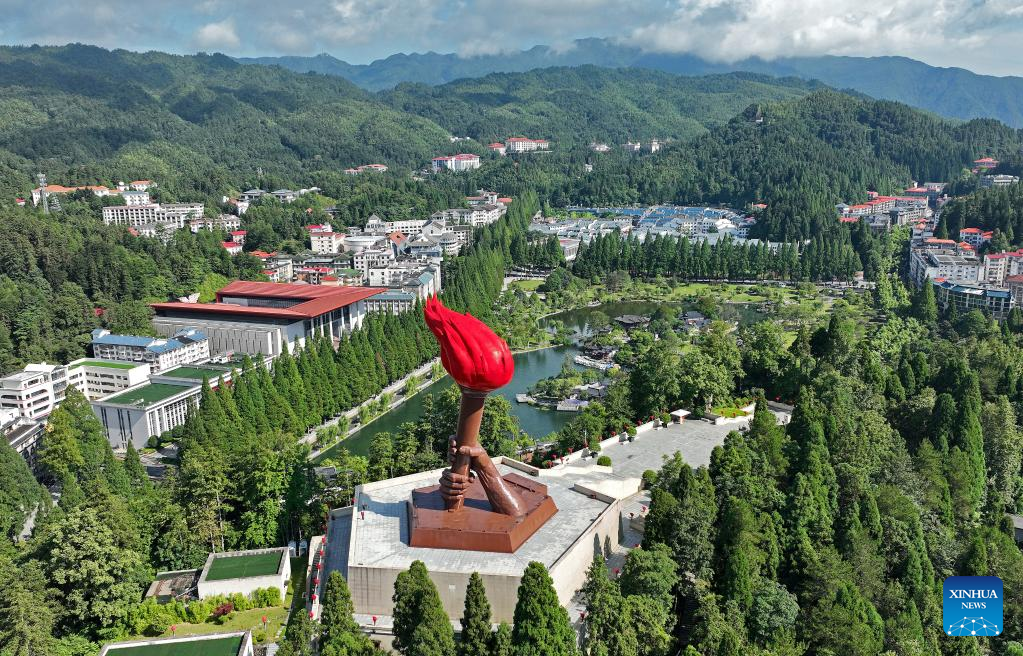
Jinggangshan.
Practical Tips for Your Visit
- Transportation: Arrive at Ji’an West Station and use the scenic area shuttle bus for convenient access to attractions.
- Accommodation: Ciping Town offers various lodging options, from hotels to charming B&Bs converted from Red Army barracks. Book in advance during peak seasons.
- What to Wear: Expect significant temperature variations; layers are advisable. Comfortable sneakers are essential for exploring the steep terrain.
By visiting these highlights, you will not only walk through the pages of history but also witness the natural wonders that make Jinggangshan a cherished destination in China. Embrace the spirit of revolution and let the majestic landscapes inspire your journey.
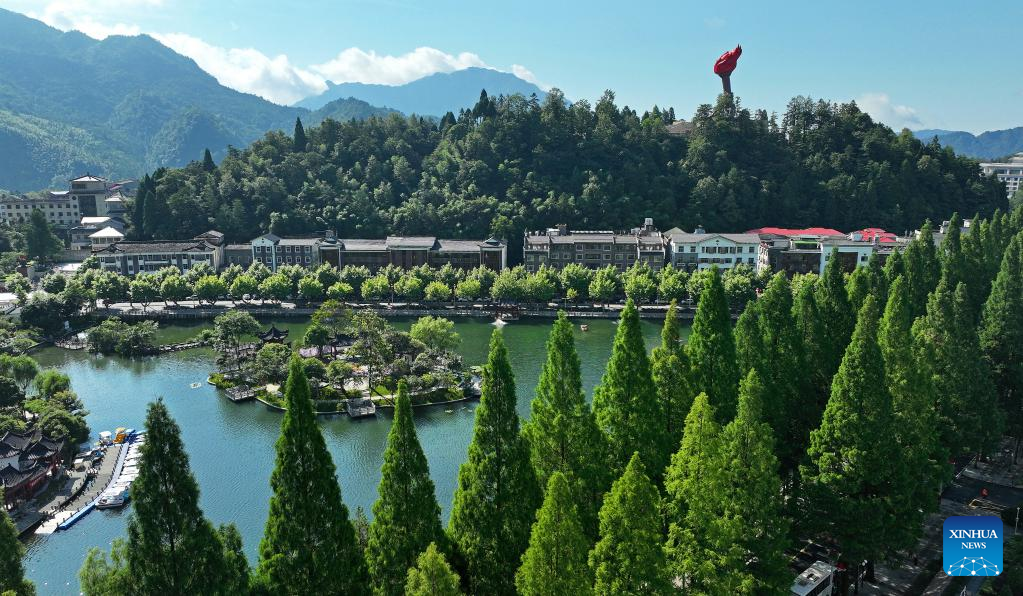
Jinggangshan.
Planning Your Visit: A Practical Guide
Your Journey to Jinggangshan: A Comprehensive Practical Guide
Nestled in the verdant heart of Jiangxi province, Jinggangshan is a destination steeped in revolutionary history and natural beauty. Often referred to as the “Cradle of the Chinese Revolution,” this area offers travelers a rich tapestry of cultural and historical experiences set against a backdrop of stunning mountainous landscapes. Here’s everything you need to know for a successful visit.
Getting There
Transportation Options:
– By Train: The nearest high-speed rail station is Ji’an West Station, which is about 20 minutes from downtown Ji’an. From there, you can catch a scenic bus to Jinggangshan (approximately 2 hours, ¥35).
– By Shuttle: A mandatory scenic area shuttle ticket (¥80 for 5 days) is required for accessing the various attractions within Jinggangshan.
– Self-Driving: For greater flexibility, consider renting a car or hiring a chartered vehicle to comfortably navigate the scenic area.

Jinggangshan.
Best Time to Visit
The ideal seasons for visiting Jinggangshan are April to May and September to October. During these months, the region showcases its natural beauty, with azaleas blooming in spring and vibrant autumn foliage. If you prefer fewer crowds, consider visiting during the summer months, although temperatures can rise significantly.
Classic Itinerary
For those keen on experiencing the essence of Jinggangshan, here’s a suggested 3-day itinerary:
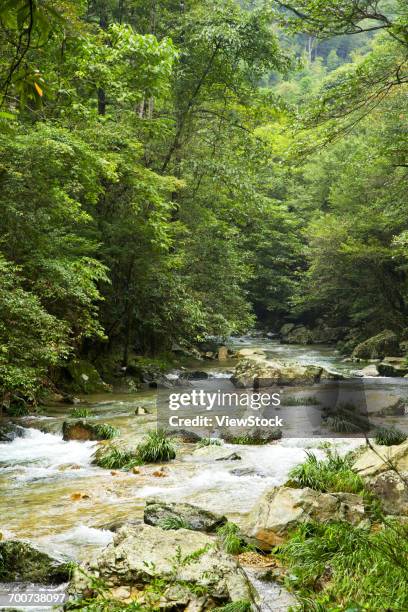
Jinggangshan.
Day 1: Red Pilgrimage
– Morning: Start your journey at Huangyangjie Pass to witness the breathtaking sea of clouds.
– Afternoon: Visit the Jinggangshan Revolutionary Museum for a detailed overview of the revolutionary history. Admission is free from 8:30 AM to 5:00 PM.
– Evening: Explore the Longtan Waterfalls, renowned for their cascading beauty. End your day with a local dining experience at the Tianjie Night Market, where you can savor traditional red rice and pumpkin soup.
Day 2: Cultural Immersion
– Morning: Discover Ciping Town, home to Mao Zedong’s former residence and other revolutionary relics.
– Afternoon: Head to Bijia Mountain for stunning views and a cable car ride through the picturesque “Ten-Mile Azalea Corridor.”
– Evening: Pay tribute at the Jinggangshan Revolutionary Martyrs Cemetery, followed by a cultural performance that brings the revolutionary spirit to life.
Day 3: Nature and History
– Morning: Ascend to Octagonal Tower where Mao Zedong penned “The Struggle in Jinggang Mountains.” Advance booking is required.
– Afternoon: Enjoy a leisurely hike to Longtan Waterfalls and experience the serenity of the natural surroundings.
– Evening: Return to Ciping Town for a relaxing evening, possibly sampling local delicacies like Jinggangshan smoked bamboo shoots and red rice wine.
Accommodation Options
- Ciping Town: This area offers a range of accommodations, from budget B&Bs to mid-range hotels, making it a convenient base for exploration.
- Unique Stays: Consider staying in a B&B converted from former Red Army barracks for an immersive experience.
- Booking Advice: During peak seasons (May to October), it’s wise to book your accommodations at least one week in advance.
Essential Tips
- Wear Comfortable Shoes: The terrain can be steep and rugged, so comfortable footwear is essential.
- Temperature Variations: Bring a jacket, as temperatures in the mountains can differ significantly from those in the city, even during summer.
- Respect Historical Sites: Maintain a quiet demeanor at revolutionary sites and exhibition areas to honor their significance.
- Stay Hydrated: Carry water, especially when hiking, to keep refreshed and energized.
Local Delicacies to Try
- Red Rice: A staple during the revolution, often served with cured meats.
- Pumpkin Soup: A sweet yet light dish that carries historical significance.
- Smoked Bamboo Shoots: A unique local delicacy that highlights the region’s culinary heritage.
- Red Rice Wine: A mellow specialty from the revolutionary base area, perfect as a souvenir.
Conclusion
Jinggangshan is not just a destination; it’s a journey through time, culture, and natural beauty. With its rich historical context and stunning landscapes, it offers an unparalleled experience for international travelers eager to delve into China’s revolutionary past. Prepare to be captivated by the stories of resilience and the breathtaking scenery that define this remarkable region.
Tickets: Prices, Booking, and Tips
When planning your visit to Jinggangshan, understanding the ticketing system, pricing, and practical tips will enhance your experience in this historically rich and naturally stunning region of China. Here’s everything you need to know to make your journey smooth and enjoyable.
Ticket Prices and Types
- Scenic Area Pass:
- Price: ¥190 per person
- Validity: This pass is valid for 5 days, allowing you to explore the various attractions at your leisure.
-
Purchase Locations: Tickets can be bought at the entrance of the scenic area or online through various travel platforms.
-
Attraction-Specific Tickets:
- Cable Car to Bijia Mountain: ¥120 per person.
- Longtan Waterfalls (one-way cable car): ¥60.
-
Guided Tour at Bailuzhou Academy: ¥20 for a guided tour, while entry is free.
-
Transportation Passes:
- Mandatory Scenic Area Shuttle Ticket: ¥80 for 5 days, essential for accessing scattered attractions within Jinggangshan.
Booking Tips
- Advance Booking: It is advisable to book your tickets at least one week in advance, especially during peak seasons (May to October) when visitor numbers surge.
- Online Options: Consider purchasing tickets online to avoid long queues at the scenic area entrances. Several Chinese travel websites offer English interfaces for international travelers.
- Accommodations: Booking your stay in Ciping Town will provide convenient access to major attractions. Many homestays and B&Bs offer packages that include tickets to scenic areas.
Practical Considerations
-
Weather Preparedness: Jinggangshan experiences significant temperature variations, so it’s wise to bring a light jacket even in summer. Early mornings and evenings can be particularly cool.
-
Footwear: Comfortable sneakers are essential, as many areas involve steep hiking. Trails can be slippery, especially near waterfalls, so ensure your shoes are suitable for such terrain.
-
Respect the Sites: As many locations are of historical significance, maintain a respectful demeanor—silence your phones and keep noise to a minimum in exhibition areas.
Transportation to Jinggangshan
-
By Train: The nearest high-speed rail station is Ji’an West Station, from which you can take a scenic bus to Jinggangshan. The bus ride lasts about 2 hours and costs roughly ¥35.
-
Self-Driving: If you prefer flexibility, consider renting a car. The attractions are spread out, and having your own vehicle can save time.
Best Time to Visit
- Optimal Seasons: The best months to visit are April to May (for blooming azaleas) and September to October (for vibrant autumn foliage). During these times, the natural beauty of the area is at its peak, making for a truly picturesque experience.
Summary
With careful planning and consideration of ticket prices, booking tips, and practical advice, your visit to Jinggangshan will be both enlightening and enjoyable. Embrace the rich history and breathtaking landscapes of this revolutionary cradle, and immerse yourself fully in this unique cultural journey.
How to Get There: A Complete Transportation Guide
Getting to Jinggangshan is an adventure in itself, offering a glimpse into the beautiful landscapes and rich history of this revolutionary site. Whether you’re coming from bustling metropolises or quieter towns, the journey to this picturesque area in Jiangxi Province is straightforward and scenic. Here’s a detailed transportation guide to help you navigate your way to this remarkable destination.
Arrival by Air
The nearest major airport to Jinggangshan is Nanchang Changbei International Airport (KHN), located approximately 300 kilometers away. From the airport, you have a couple of travel options:
- High-Speed Rail: Take a high-speed train from Nanchang to Ji’an West Station, which takes around 1.5 to 2 hours. This is the most efficient and comfortable option.
- Taxi or Rideshare: If you prefer direct transport, you can hire a taxi or use a rideshare service to reach Jinggangshan directly from the airport, though this may take around 4-5 hours.
Train Travel
For travelers already in China, taking the train is a convenient option:
- High-Speed Train: Board a high-speed train to Ji’an West Station. Trains run frequently from major cities including Shanghai, Guangzhou, and Beijing. The journey duration varies based on your departure point but generally ranges from 6 to 10 hours.
Local Transportation from Ji’an to Jinggangshan
Once you arrive at Ji’an West Station, getting to Jinggangshan is simple:
- Scenic Bus:
- Duration: Approximately 2 hours
- Cost: ¥35
-
Frequency: Buses depart regularly from Ji’an West Station to the Jinggangshan Scenic Area.
-
Taxi:
- For a more direct route, taxis are available outside the station. Expect to pay around ¥150-200 for the journey, which takes about 1.5 hours.
Navigating Jinggangshan
Once you arrive at the Jinggangshan Scenic Area, you’ll find that attractions are spread out across the mountainous terrain. To make the most of your visit, consider the following transportation options:
- Mandatory Scenic Area Shuttle Bus:
- Cost: ¥80 for a 5-day pass
-
This shuttle service is essential as it connects major attractions within the scenic area, making it easier to explore without the hassle of driving.
-
Self-Driving:
- If you prefer the freedom of your own schedule, renting a car is a viable option. The roads are well-maintained and offer stunning views of the landscape.
Practical Tips for Travelers
- Weather Considerations: Be prepared for significant temperature variations in the mountains. Carry a jacket, even in summer, as it can get chilly.
- Comfortable Footwear: The terrain can be steep and uneven, so sturdy sneakers or hiking shoes are recommended for comfort and safety.
- Plan Ahead: During peak seasons (May to October), accommodations and transportation can fill up quickly. Booking in advance is highly advisable.
Conclusion
Journeying to Jinggangshan is not merely a means of travel; it’s an integral part of experiencing the cultural and historical richness of this revolutionary landmark. With a variety of transportation options at your disposal, you’re well-equipped to embark on an unforgettable adventure into the heart of one of China’s most significant historical sites. Whether you’re drawn by the lush landscapes or the revolutionary history, Jinggangshan promises a rewarding experience for all who visit.
Local Cuisine and Accommodation Nearby
Discovering Jinggangshan’s Flavors and Stays
As you traverse the breathtaking landscapes and rich history of Jinggangshan, the local cuisine and accommodations offer a delightful complement to your journey. This region, celebrated as the birthplace of the Chinese Red Army, not only provides an immersive historical experience but also tantalizes your taste buds with unique flavors rooted in tradition.
Culinary Delights
Exploring Jinggangshan’s local cuisine is a must. Here are some dishes you shouldn’t miss:
-
Red Rice: Once a staple for revolutionaries, this hearty grain is now served with various accompaniments, particularly farmhouse cured meats. Its nutty flavor makes it a delicious choice for any meal.
-
Pumpkin Soup: A comforting dish that combines sweet and savory notes, this soup is reminiscent of meals shared by the Red Army, offering a taste of history in every spoonful.
-
Jinggangshan Smoked Bamboo Shoots: This local delicacy offers a unique texture and a fragrant aroma, making it an excellent side dish or snack.
-
Red Rice Wine: A specialty of the area, this mellow wine pairs beautifully with the local fare, encapsulating the region’s cultural heritage in a glass.
For a true taste of local cuisine, consider dining at the Tianjie Night Market in Ciping Town. Here, you can sample a variety of dishes, including red rice and pumpkin soup, often for around ¥50 per person. The market’s vibrant atmosphere enhances your culinary experience, allowing you to mingle with locals and other travelers.
Where to Stay
When it comes to accommodation, Jinggangshan offers a range of options to suit different preferences and budgets:
-
Ciping Town: This area serves as the primary hub for visitors, providing a variety of hotels and B&Bs. Here, you can find lodgings ranging from budget-friendly options to more luxurious stays. Many establishments offer unique experiences, such as B&Bs converted from former Red Army barracks, allowing guests to immerse themselves in revolutionary history.
-
Homestays: For an authentic experience, consider a homestay in Ciping Town. Prices typically range from ¥150 to ¥300 per night, providing a cozy and culturally rich atmosphere.
-
Luxury Accommodations: If you’re looking for a more upscale experience, the Grand Skylight International Hotel in Ji’an offers stunning views of the Gan River and modern amenities, with rates starting at around ¥500 per night.
-
Budget Options: The Bailuzhou Hotel in downtown Ji’an is a solid choice for budget-conscious travelers, offering comfortable accommodations near local attractions for approximately ¥300 a night.
Planning Your Stay
To ensure a smooth experience, especially during peak tourist seasons (from May to October), it’s advisable to book your accommodations at least a week in advance. This way, you can secure your preferred choice and avoid the last-minute rush.
Whether you’re savoring the unique flavors of Jinggangshan’s local cuisine or resting in lodgings rich with historical significance, your visit to this iconic area promises to be both enriching and memorable.
Frequently Asked Questions
Frequently Asked Questions
1. Where is Jinggangshan located?
Jinggangshan is nestled in the heart of the Luoxiao Mountains in Jiangxi province, near the border with Hunan province. It is renowned for its stunning natural landscapes and rich historical significance as the birthplace of the Chinese Red Army.
2. What are the best times to visit Jinggangshan?
The ideal times to visit are during spring (April-May) when rhododendrons bloom, and autumn (September-October) when the maple trees display vibrant colors. These seasons offer pleasant weather and breathtaking scenery.
3. How can I get to Jinggangshan?
Travelers can arrive at Ji’an West Station via high-speed rail. From there, you can take a scenic bus (approximately 2 hours, ¥35) to Jinggangshan. A mandatory area shuttle ticket (¥80) is required for exploring the various attractions within the scenic area.
4. What are the must-visit attractions in Jinggangshan?
Key attractions include:
– Jinggangshan Revolutionary Museum: A comprehensive showcase of the revolutionary history.
– Huangyangjie Pass: Famous for its sea of clouds and panoramic views.
– Mao Zedong’s Former Residence in Ciping: A glimpse into the life of the revolutionary leader.
– Longtan Waterfalls: A spectacular natural wonder with cascading waterfalls.
– Jinggangshan Revolutionary Martyrs Cemetery: A solemn tribute to those who sacrificed for the revolution.
5. What should I pack when visiting Jinggangshan?
Given the area’s significant temperature variations, it’s advisable to bring a jacket, even in summer. Comfortable sneakers are essential for walking on steep and rugged terrain. Don’t forget your camera to capture the stunning landscapes!
6. Are there any local foods I should try?
Absolutely! While in Jinggangshan, be sure to sample:
– Red Rice: A staple dish enriched with history.
– Pumpkin Soup: A sweet and light dish favored by local cuisine.
– Jinggangshan Smoked Bamboo Shoots: A unique local delicacy.
– Red Rice Wine: A mellow specialty with a fascinating backstory.
7. What accommodation options are available?
Ciping Town offers a range of accommodations, from budget hostels to mid-range hotels. For a unique experience, consider staying at a B&B converted from former Red Army barracks. It’s wise to book in advance, especially during peak tourist season (May-October).
8. Is there anything I should be careful about while visiting?
Yes, be respectful at revolutionary sites by maintaining a quiet demeanor. Additionally, avoid purchasing low-quality “Red Army herbs” and “red rice wine” from street vendors. Keep your shuttle tickets handy, as they are required for every ride within the scenic area.
Final Thoughts on Your Trip
As you wrap up your journey through Jinggangshan, you may find yourself reflecting on the intricate tapestry of history, culture, and breathtaking natural beauty that this region offers. Known as the “Cradle of the Chinese Revolution,” Jinggangshan stands as a testament to the resilience and spirit of those who fought for their beliefs amidst the rugged mountains and lush landscapes.
A Journey of Discovery
Your exploration through this historic area has likely taken you to significant sites like Mao Zedong’s Former Residence and the Jinggangshan Revolutionary Museum, where the stories of valor and sacrifice come alive. Each location not only showcases the struggles of the past but also invites you to connect with the ideals of perseverance and hope that continue to resonate today.
-
Natural Beauty: Whether it was the stunning vistas from Huangyangjie or the serene tranquility of the Longtan Waterfalls, the natural scenery has undoubtedly left a lasting impression. The majestic mountains and vibrant flora serve as a backdrop to the rich historical narratives, creating an experience that is both enlightening and rejuvenating.
-
Culinary Delights: Your taste buds have also embarked on a journey, savoring local dishes such as red rice and pumpkin soup, each bite infused with history and tradition. These culinary offerings not only nourish the body but also connect you to the local culture and its revolutionary past.
Final Thoughts
As you prepare to leave Jinggangshan, take with you not just memories of its breathtaking landscapes and historical sites but also a deeper understanding of the spirit of its people. This region is more than a destination; it is a living testament to the resilience of human spirit and the enduring quest for freedom and justice.
We hope this experience has inspired you to continue exploring the rich tapestry of Chinese history and culture. With every journey, you add your own story to the narrative of places like Jinggangshan, contributing to the ongoing dialogue between the past and the present.
Safe travels as you embark on your next adventure, and may the spirit of Jinggangshan accompany you wherever you go!